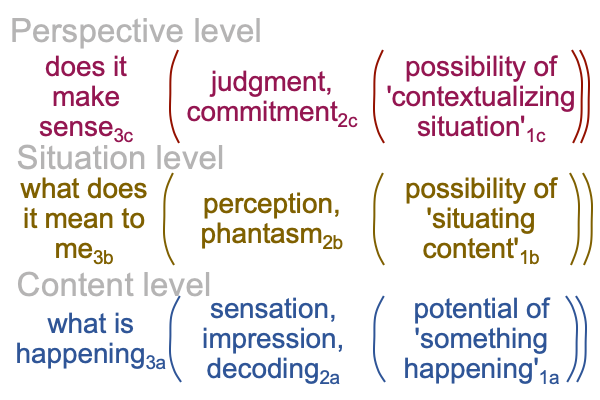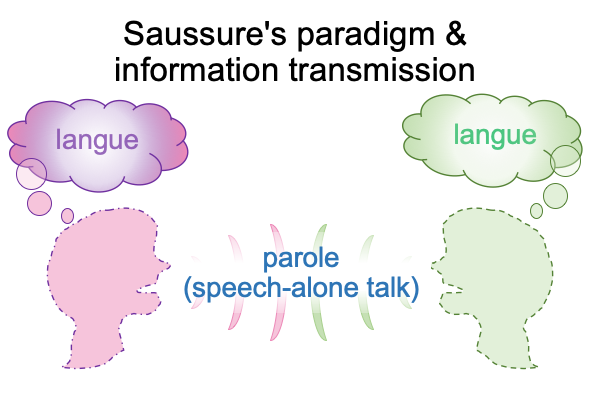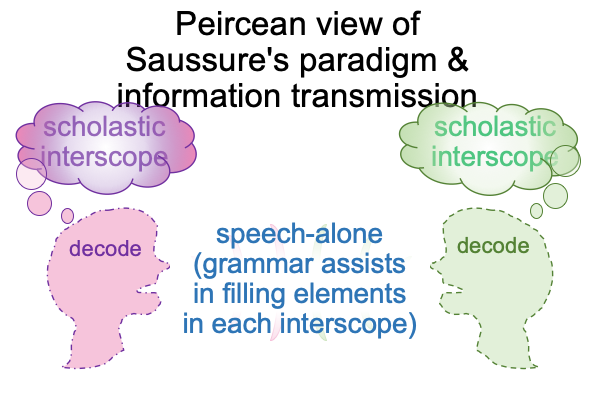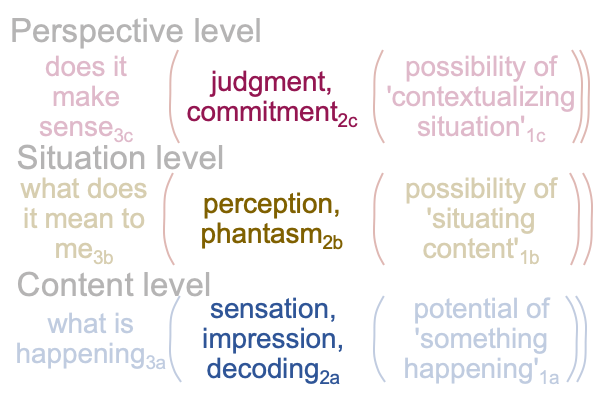0246 Right at the start, a model… or some sort of picture… of how humans think should help.
For the uninitiated, A Primer on the Category-Based Nested Form and A Primer on Sensible and Social Construction(by Razie Mah, available at smashwords and other e-book venues) should assist.
0247 Why do I say that?
The following figure presents the scholastic diagram of how humans think. The interscope is partially developed in Comments on John Deely’s Book (1994) New Beginnings and completely elaborated in Razie Mah’s blog for October 2023, Looking at John Deely’s Book (2010) “Semiotic Animal”.

0248 On the content level, the normal context of what is happening3a brings the actuality of sensation, impression and decoding2a into relation with the potential of ‘something happening’1a. The actuality2a is dyadic. That is not apparent here. Instead, I present a gradation, where sensation is close to consciousness, impression is liminal, and decoding is automatic and unconscious.
On the situation level, the normal context of what it means to me3b brings the actuality of perception and phantasm2binto relation with the possibility of ‘situating content’1b. Again, the actuality2b is dyadic. That is not apparent here. Instead, perception2a goes with consciousness and phantasm2b associates to unconsciousness… or should I say?… the bicameral mind.
On the perspective level, the normal context of does it make sense3c brings the actuality of judgment and commitment2cinto relation with the possibility of ‘contextualizing the situation’1c. Here, the actuality2c is a triadic relation. For judgment2c, the conditions for its actuality2c associate to consciousness. For commitment2c, the conditions for its actuality2c go with the bicameral mind.
0249 Does the above figure have anything to do with language?
In Comments on Robert Berwick and Noam Chomsky’s Book (2016) Why Only Us?, Razie Mah suggests that the above interscope corresponds to langue.
0250 Langue?
Ferdinand de Saussure (1859-1913) revolutionizes the discipline of linguistics by defining “language” as two arbitrarily related systems of differences, parole (speech) and langue (mental speech processing).
Doesn’t that sound scientific?
0251 Yes and no.
Yes, the phenomena of parole are easily observed and measured because speech serves as the medium for communication.
No, the phenomena of langue cannot be directly observed and measured. Indeed, the phenomena of langue depend on what the scientist thinks that the noumenon of language must be.
0252 For example, the modern cognitive psychologist says that the thing itself (langue) consists of patterns of neuronal excitation and inhibition in the human brain.
Then, modern cognitive psychologists insist that all government research funds devoted to language processing pass through the articulated agenda.
0253 I offer this morsel of bureaucratic reality as an excuse for why Mithen cannot accept the gestural origins of language in hominin evolution. Research programs in cognitive and evolutionary psychology exclude gestural origins because it does not fit what they imagine langue must be. How can a subject conduct a conversation in hand talk while belted down in a functional MRI scanner?
0254 Indeed, today, the current metaphor of information transmission applies to speech-alone talk.
Here is a picture.

0255 The visualization of language as information transmission is so powerful that cognitive scientists simulate the origins of grammar as a spontaneous second-order effect of a sequence of transmissions. The langue aspect does not have much to do with it, except as a constraint.
This is discussed in chapter eight of Mithen’s The Language Puzzle. The chapter title is “Lessons from an Artificial Language”.
0256 Is there another way to look at this transmission metaphor?
If (the noumenon of) langue is depicted as the scholastic interscope for how people think, then grammar arises within parole as symbolic operations that assist in filling the blanks for each element in the interscope.
0257 For Saussure, parole is a system of differences. Each spoken word is distinctly different from any other spoken word (with a few exceptions). The difference is on the basis of habit, convention, law, tradition and so on. That makes each spoken word a symbol. In Peirce’s terminology, a symbol is a sign-relation whose sign-object is determined on the basis of habit, convention, law, tradition and so forth.
For Peirce, a symbolic order is a finite collection of symbols. Symbolic orders allow symbolic operations. For spoken words, those symbolic operations are called, “grammar”.
0258 Consequently, I may depict Saussure’s semiological paradigm and the metaphor of information transmission in terms of Peirce’s categorical framework.

Parole manifests as speech-alone talk. Speech-alone contains a finite number of symbols. Each symbol is (for the most part) distinct from any other symbol. A symbolic order is composed of a finite number of symbols. A symbolic order supports symbolic operations. For language, those symbolic operations go under the label, “grammar”.
0259 So, what are symbolic operations supposed to do?
They assist in attaching symbols (spoken words) to empty slots in a purely relational interscope.
0260 What about the word, “decode”?
Each symbol carries meaning, presence and message. The symbol is automatically decoded into these three potentials. Then, these potentials should appear in an empty slot or refine an occupied slot in the scholastic interscope for how humans think.
0261 At first, decoding operations fill in the slot2a on the content-level.
Then, the next slot to be filled in is the actuality2b on the situation level.
Then, if necessary, the perspective-level actuality2c comes into play.
Here is a picture that highlights the virtual nested form in the category of secondness.

